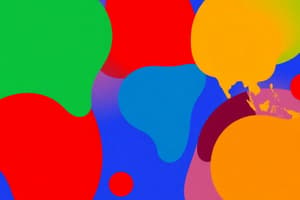Podcast
Questions and Answers
What is an object in the context of a class?
What is an object in the context of a class?
- A general template for creating multiple instances
- A specific instance of the class with its own values for an attribute (correct)
- A specific instance of the class with shared values for an attribute
- A collection of classes with similar characteristics
What is the term for the number of associations between classes in UML?
What is the term for the number of associations between classes in UML?
- Cardinality
- Multiplicity (correct)
- Relationship
- Association
What is the difference between an association and a relationship?
What is the difference between an association and a relationship?
- A relationship is between entities, while an association is between classes
- An association is in UML, while a relationship is in ERD (correct)
- A relationship is in UML, while an association is in ERD
- An association is mandatory, while a relationship is optional
What is the minimum constraint in an association?
What is the minimum constraint in an association?
How should you read associations and relationships?
How should you read associations and relationships?
What is the term for the number of relationships in ERD?
What is the term for the number of relationships in ERD?
What is another term for 'domain classes' in database classes?
What is another term for 'domain classes' in database classes?
What technique uses a checklist of typical types of things to identify domain classes?
What technique uses a checklist of typical types of things to identify domain classes?
What is the first step in identifying domain classes?
What is the first step in identifying domain classes?
What type of things are typically found in brainstorming for domain classes?
What type of things are typically found in brainstorming for domain classes?
What is the purpose of identifying domain classes?
What is the purpose of identifying domain classes?
What is the next step after identifying a user and a set of use cases?
What is the next step after identifying a user and a set of use cases?
What is the outcome of the brainstorming process for identifying domain classes?
What is the outcome of the brainstorming process for identifying domain classes?
What is the final step in the process of identifying domain classes?
What is the final step in the process of identifying domain classes?
What is the purpose of the association class in Systems Analysis and Design?
What is the purpose of the association class in Systems Analysis and Design?
What is the key for the Booking class?
What is the key for the Booking class?
What is the term for a hierarchical relationship where subordinate classes are special types of the superior classes?
What is the term for a hierarchical relationship where subordinate classes are special types of the superior classes?
What is the superior or more general class in a generalization/specialization hierarchy?
What is the superior or more general class in a generalization/specialization hierarchy?
What is the concept that subclasses inherit characteristics of the more general superclass?
What is the concept that subclasses inherit characteristics of the more general superclass?
What is an abstract class?
What is an abstract class?
What are the attributes of OnlineSale?
What are the attributes of OnlineSale?
What do subclasses inherit from the superclass?
What do subclasses inherit from the superclass?
What type of relationship exists between a car and its wheels?
What type of relationship exists between a car and its wheels?
What is the term for a whole-part relationship where the component part exists separately and can be removed and replaced?
What is the term for a whole-part relationship where the component part exists separately and can be removed and replaced?
What symbol is used to represent composition in UML diagrams?
What symbol is used to represent composition in UML diagrams?
What is the main difference between aggregation and composition?
What is the main difference between aggregation and composition?
What is the term for a relationship where one class is a component or part of another class?
What is the term for a relationship where one class is a component or part of another class?
How many types of relationships are there in class diagrams?
How many types of relationships are there in class diagrams?
What is an example of a composition relationship?
What is an example of a composition relationship?
What is the term for a relationship where a subclass inherits characteristics from a parent class?
What is the term for a relationship where a subclass inherits characteristics from a parent class?
How many domain classes are in the RMO CSMS overall?
How many domain classes are in the RMO CSMS overall?
What is the purpose of creating an initial draft of the domain model class diagram?
What is the purpose of creating an initial draft of the domain model class diagram?
What is the benefit of creating one domain model class diagram per subsystem?
What is the benefit of creating one domain model class diagram per subsystem?
What may happen when reviewing the use cases from Chapter 3?
What may happen when reviewing the use cases from Chapter 3?
What is the purpose of creating an overall domain model class diagram?
What is the purpose of creating an overall domain model class diagram?
In what stage of the project is the initial draft of the domain model class diagram usually completed?
In what stage of the project is the initial draft of the domain model class diagram usually completed?
What should be done when reviewing the use cases from Chapter 3?
What should be done when reviewing the use cases from Chapter 3?
What can be done with the complete RMO CSMS Domain Model Class Diagram?
What can be done with the complete RMO CSMS Domain Model Class Diagram?
Flashcards are hidden until you start studying
Study Notes
Domain Classes and Entities
- In systems analysis and design, "things" are modeled as domain classes or data entities.
- A domain class is a type of thing that has attributes and relationships with other domain classes.
Identifying Domain Classes
- Use brainstorming techniques to identify domain classes, such as:
- Checklist of typical types of things found in a system (e.g., tangible things, organizational units, sites/locations, incidents/events).
- Noun technique (identify all nouns in the system description and determine if they are domain classes, attributes, or not relevant).
- Identify users and stakeholders to gather information about things involved in the use case.
Domain Classes and Objects
- A domain class is a general concept, whereas an object is a specific instance of the class, with its own attribute values.
Associations and Relationships
- Associations are naturally occurring relationships between classes (e.g., UML term).
- Multiplicity refers to the number of associations between classes (e.g., 1:1 or 1:many).
- Associations can be read in both directions (e.g., "A customer places an order" and "An order is placed by a customer").
- Associations have minimum and maximum constraints, which can be optional or mandatory.
Generalization/Specialization
- Generalization/specialization is a hierarchical relationship where subordinate classes are special types of the superior class.
- Inheritance is the concept that subclasses inherit characteristics of the more general superclass.
Abstract and Concrete Classes
- Abstract classes allow subclasses to inherit characteristics but are never instantiated.
- Concrete classes can have instances.
Whole-Part Relationships
- Whole-part relationships are relationships between classes where one class is part of or a component of another class.
- Aggregation is a whole-part relationship where the component part exists separately and can be removed and replaced.
- Composition is a whole-part relationship where the parts cannot be removed.
Class Diagrams
- There are three types of relationships in class diagrams: association relationships, whole-part relationships, and generalization/specialization relationships.
- Domain model class diagrams show the classes and relationships in a system.
Creating a Domain Model Class Diagram
- There are several ways to create a domain model class diagram, including creating one overall diagram or one per subsystem.
- The domain model class diagram is used to guide development and is updated throughout the development process.
Studying That Suits You
Use AI to generate personalized quizzes and flashcards to suit your learning preferences.




